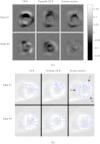A quantitative study of motion estimation methods on 4D cardiac gated SPECT reconstruction
- PMID: 22894443
- PMCID: PMC3422358
- DOI: 10.1118/1.4738377
A quantitative study of motion estimation methods on 4D cardiac gated SPECT reconstruction
Abstract
Purpose: Motion-compensated temporal processing can have a major impact on improving the image quality in gated cardiac single photon emission computed tomography (SPECT). In this work, we investigate the effect of different optical flow estimation methods for motion-compensated temporal processing in gated SPECT. In particular, we explore whether better motion estimation can substantially improve reconstructed image quality, and how the estimated motion would compare to the ideal case of known motion in terms of reconstruction.
Methods: We consider the following three methods for obtaining the image motion in 4D reconstruction: (1) the Horn-Schunck optical flow equation (OFE) method, (2) a recently developed periodic OFE method, and (3) known cardiac motion derived from the NURBS-based cardiac-torso (NCAT) phantom. The periodic OFE method is used to exploit the inherent periodic nature in cardiac gated images. In this method, the optical flow in a sequence is modeled by a Fourier harmonic representation, which is then estimated from the image data. We study the impact of temporal processing on 4D reconstructions when the image motion is obtained with the different methods above. For quantitative evaluation, we use simulated imaging with multiple noise realizations from the NCAT phantom, where different patient geometry and lesion sizes are also considered. To quantify the reconstruction results, we use the following measures of reconstruction accuracy and defect detection in the myocardium: (1) overall error level in the myocardium, (2) regional accuracy of the left ventricle (LV) wall, (3) accuracy of regional time activity curves of the LV, and (4) perfusion defect detectability with a channelized Hotelling observer (CHO). In addition, we also examine the effect of noise on the distortion in the reconstructed LV wall shape by detecting its contours. As a preliminary demonstration, these methods are also tested on two sets of clinical acquisitions.
Results: For the different quantitative measures considered, the periodic OFE further improved the reconstruction accuracy of the myocardium compared to OFE in 4D reconstruction; its improvement in reconstruction almost matched that of the known motion. Specifically, the overall mean-squared error in the myocardium was reduced by over 20% with periodic OFE; with noise level fixed at 10%, the regional bias on the LV was reduced from 20% (OFE) to 14% (periodic OFE), compared to 11% by the known motion. In addition, the CHO results show that there was also improvement in lesion detectability with the periodic OFE. The regional time activity curves obtained with the periodic OFE were also observed to be more consistent with the reference; in addition, the contours of the reconstructed LV wall with the periodic OFE were demonstrated to show less degree of variations among different noise realizations. Such improvements were also consistent with the results obtained from the clinical acquisitions.
Conclusions: Use of improved optical flow estimation can further improve the accuracy of reconstructed images in 4D. The periodic OFE method not only can achieve improvements over the traditional OFE, but also can almost match that of the known motion in terms of the several quality measures considered.
Figures











Similar articles
-
Limited-angle effect compensation for respiratory binned cardiac SPECT.Med Phys. 2016 Jan;43(1):443. doi: 10.1118/1.4938579. Med Phys. 2016. PMID: 26745937 Free PMC article.
-
Effects of motion, attenuation, and scatter corrections on gated cardiac SPECT reconstruction.Med Phys. 2011 Dec;38(12):6571-84. doi: 10.1118/1.3660328. Med Phys. 2011. PMID: 22149839 Free PMC article.
-
4D reconstruction for low-dose cardiac gated SPECT.Med Phys. 2013 Feb;40(2):022501. doi: 10.1118/1.4773868. Med Phys. 2013. PMID: 23387768 Free PMC article.
-
Dynamic single photon emission computed tomography--basic principles and cardiac applications.Phys Med Biol. 2010 Oct 21;55(20):R111-91. doi: 10.1088/0031-9155/55/20/R01. Epub 2010 Sep 22. Phys Med Biol. 2010. PMID: 20858925 Free PMC article. Review.
-
Cardiac MRI at Low Field Strengths.J Magn Reson Imaging. 2024 Feb;59(2):412-430. doi: 10.1002/jmri.28890. Epub 2023 Aug 2. J Magn Reson Imaging. 2024. PMID: 37530545 Free PMC article. Review.
Cited by
-
Limited-angle effect compensation for respiratory binned cardiac SPECT.Med Phys. 2016 Jan;43(1):443. doi: 10.1118/1.4938579. Med Phys. 2016. PMID: 26745937 Free PMC article.
-
Fast spatiotemporal image reconstruction based on low-rank matrix estimation for dynamic photoacoustic computed tomography.J Biomed Opt. 2014 May;19(5):056007. doi: 10.1117/1.JBO.19.5.056007. J Biomed Opt. 2014. PMID: 24817620 Free PMC article.
-
4-D Reconstruction With Respiratory Correction for Gated Myocardial Perfusion SPECT.IEEE Trans Med Imaging. 2017 Aug;36(8):1626-1635. doi: 10.1109/TMI.2017.2690819. Epub 2017 Apr 4. IEEE Trans Med Imaging. 2017. PMID: 28391190 Free PMC article.
-
4D non-local means post-filtering for cardiac gated SPECT.Phys Med Biol. 2018 Jan 31;63(3):035026. doi: 10.1088/1361-6560/aaa44d. Phys Med Biol. 2018. PMID: 29283356 Free PMC article.
-
Noise suppressed partial volume correction for cardiac SPECT/CT.Med Phys. 2016 Sep;43(9):5225. doi: 10.1118/1.4961391. Med Phys. 2016. PMID: 27587054 Free PMC article.
References
-
- Garcia E. V., “Imaging guidelines for nuclear cardiology procedures part I,” J. Nucl. Cardiol. 3, G1–G46 (1996). - PubMed
-
- Klein G. J., Reutter B. W., and Huesman R. H., “Non-rigid summing of gated PET via optical flow,” IEEE Trans. Nucl. Sci. 44, 1509–1512 (1997). 10.1109/23.632704 - DOI
-
- Mair B. A., Gilland D. R., and Cao Z., “Simultaneous motion estimation and image reconstruction from gated data,” in Proceedings of the IEEE International Symposium on Biomedical Imaging: Macro to Nano (IEEE, 2002), pp. 661–664.
Publication types
MeSH terms
Grants and funding
LinkOut - more resources
Full Text Sources
Research Materials

